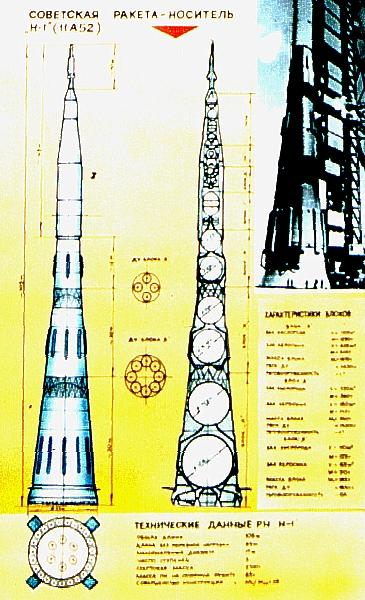相信不少人不理解N-1的设计:为什么要堆这么多煤油机?难道就不能把二级做小一点吗?人家土五哪里用得着这么大的起飞推力?少分点级会死吗?
 硕大的五级火箭,N-1
硕大的五级火箭,N-1当然,这些都是为了满足任务要求。然而,如果能使用高比冲的氢氧机的话,也许N-1的一级会小不少——它的命运也不会那么地不幸。
那么,来到了这个新问题:
为什么苏联不在重型火箭中使用氢氧机?
Quora上一位自称和苏联/俄罗斯航天专家交流过的技术人员提出了如下的见解:氢氧机的测试和点火需要大量氦气吹除任何其他气体,而苏联无法(至少对航天计划来说)提供氦气。值得注意的是,这位老哥在Quora的身份也符合他的回复(“曾在NASA工作42年”,头像也很…呃…复古?)。也许他说的情况属实吧?
正文和翻译如下:
HI Everyone— I found this question just ‘by accident’, and I would like to contribute a point that is relevant here.
(打招呼)
The former Soviet Union did indeed do some early development work on the use of Liquid Hydrogen (LH2) in their launch vehicles, but had to abandon it before it got very far (I know this from having talked to several of their development people in about 1990).
(苏联的确做了一些将氢氧机用在运载火箭上的早期研发工作,但是不得不很快就停止了(我在1990年和一些负责开发的人员聊过))
When cryogenic propellants are employed in a launch vehicle, the propellant system(s) must be ‘purged’ and ‘inerted’ prior to introduction of the cryogenic fluid. In the case of LOX, if this ‘inerting’ is not performed and atmospheric air is present in the propellant systems, humidity in the air will condense and freeze. This is not permissible. To inert the LOX system properly, a fluid like Gaseous Nitrogen (GN2) is used as a purging agent. Repeated purging of the LOX system with GN2 (or even sufficiently dry Air) will remove the moisture from the system and allow the LOX system to function as intended.
(当低温推进剂要被注入运载火箭的时候,火箭必须先被“清除气体”或“钝化”。不加处理就直接注入推进剂的话,会导致储罐内大气成分的空气(其中包括水分之类的物质)冻结,而这会造成很有害的影响。对于液氧来说,多次注入再抽出一些流体,比如氮气或者甚至干燥的空气就可以排除不想要的水分。)
If LH2 is employed in a system, we must not only remove the moisture (i.e., the Water) from the system, but we must remove all traces of Oxygen and Nitrogen also (i.e., we must remove all the atmospheric air) because these gases will freeze at LH2 temperatures.
(然而,如果使用液氢的话,就必须同时移除储罐剩余气体中的水分、氮气和氧气。这是因为与液氢同时储存的时候,这些气体也会冻住。)
The only inert fluid medium that will maintain a vapor phase in the presence of LH2 is Helium. This is what we use to do all purging and inerting of LH2 systems prior to introducing the propellant.
(唯一能够在液氢的温度下作为气体存在的物质就是氦气。所以我们必须用氦气对将要存储液氢的储罐进行处理。)
During those years, the Soviet Union did not have an indigenous source of Gaseous Helium. And, because of its strategic value, the US would not sell Helium to the Soviet Union. This situation rendered them unable to build and operate LH2 systems with any degree of safety.
(在那些年代苏联没有国内的氦气来源。【注:存疑?早上起来再补资料来源= =】当然,美国也不会向苏联出售氦气,因为这可是一种战略性物资啊!所以,那个时候苏联无法安全使用任何涉及液氢的系统。)
The former Soviet people that I was lucky enough to get to talk to did tell me that (for a while) they tried to operate prototype LH2 systems using Gaseous Hydrogen (GH2) as a purging agent. This was a disaster. Besides an inability to positively control system pressures (due to ullage collapse of the GH2 pressurant gas in the presence of LH2), the inevitable leakage that was encountered (often in confined spaces, such as the interior of a launch vehicle fuselage) created a terrible explosive hazard. They suffered fatalities on this account.
(我幸会的那些苏联人告诉我,当时苏联的确试图用气态氢气来“洗掉”液氢储罐里的其他物质。很可惜这个方法完全不可靠。首先,这样无法正向地控制储罐内部压强(猜猜液氢和气态氢放在一起时会发生什么?氢气会液化啊朋友们!)进而无法维持推进剂沉底。同时,氢气作为易逸散的气体也会从储罐中逸出。这两个因素导致当时苏联的氢氧火箭系统很喜欢爆炸。这种爆炸是致命的。)
I know this issue might not be considered to be a ‘mainline’ problem of the topic discussed here, but it turns out to be one of the deciding factors.
(这件事算不上一个“主线”上的问题,但它正好就变成了一个如此关键的问题。)
Thank you very much.